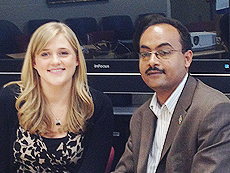“Countries have to be in the driver’s seat and set the agendaâ€Â, Dr. Kesetebirhan Admasu

Dr. Kesetebirhan Admasu, the Ethiopian Minister of Health, visited Johns Hopkins Bloomberg School of Public Health to talk about the successes and challenges of Ethiopia’s innovative Health Extension Program.
His talk was sponsored by Johns Hopkins Center for Global Health and the Bill and Melinda Gates Institute for Population and Reproductive Health. The minister sat with Hannah Olson, MSPH Candidate in the Department of Population, Family and Reproductive Health for an interview at the school. Dr. Kesetebirhan spoke of Ethiopia’s rapidly developing health system and described a vision for the future of the Health Extension Program. The Ministry of Health aims to incorporate more innovative technologies and eventually evolve the program into a more complex family-based healthcare model. As the program expands, a career ladder for Health Extension Workers will provide opportunities for advancement to higher-levels of service delivery. The basic principles of country ownership, stakeholder engagement, and community empowerment drive the work of the Ministry. The Health Extension Program is one pillar of the health system that was designed to serve these basic principles and the results have been promising. The interview first appeared on the Johns Hopkins School of Public Health’s website.
Excerpts:
Question: I want to start by talking about one of Ethiopia’s huge successes. At the beginning of the year you hosted the African Leadership for Child Survival meeting. Ethiopia has had huge success in reducing the number of preventable deaths of children under-five by 60 percent in the last 20 years. What do you think are the biggest contributors to that decline?
Dr. Kesetebirhan Admasu: I think the right policies and strategies have been put in place over the last two decades to reduce under-five mortality rates in Ethiopia. One of the strategies is to improve access to basic health services to the majority of the population in Ethiopia. Before 1991, most of our health facilities were concentrated in urban areas, where only 15 percent of the population resides. The majority of the population that lives in the rural areas didn’t have access to basic health services. So the government has set up a policy that makes access to basic health services a priority and not only access to basic health services, but also a focus on prevention of diseases and promotion of health. So I believe that with this policy and strategy we have improved access and we have been able to control malaria, improve immunization coverage, and improve resilience to malnutrition. We have also improved case management of common childhood illnesses by engaging and involving our community Health Extension Workers. So overall, with an emphasis on prevention and promotion, and with access to basic health services, we have managed to achieve a reduction in under-five mortality. Read more

